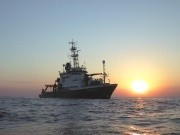|
afrol News, 20 January - A strange phenomenon in the shallow waters of South-western Africa, regular eruptions of toxic hydrogen sulphide, are about to be mapped and studied. These gas discharges change the ocean's blue colour into turquoise and result in extensive fish deaths. The German research vessel "Meteor" has left Cape Town to find out why. The Research Centre Ocean Margins, located in Bremen (Germany), today announced its scientists were set to "trace poisonous gases in the ocean" off the coast of Namibia the South Africa's Cape provinces. An expedition on board RV "Meteor" today left Cape Town, having several tasks within the field of marine research, the Centre said. The geologists, geochemists, geophysicists and oceanographers were to concentrate on "processes on and in the seafloor." The main focus was on the poisonous gases discharges, an odd phenomenon with economic consequences. Massive hydrogen sulphide gas eruptions from the ocean floor are a well-known phenomenon off Namibia. Due to the Namibian Benguela system of upwelling water, these coasts are among the richest in the world in terms of organic production. Hence, fisheries are a major industry at these coasts. The Namibian and South African fisheries however experience regular abruptions as dead fish and other maritime life forms are floating ashore in enormous quantities. Another eruption of hydrogen sulphide has thus taken place. The gas, which is toxic for marine life forms, however kills less than the sudden depletion of water-bound oxygen, suffocating those unable to escape. The gas eruptions obviously are an old phenomenon, as marine life has somewhat adapted to it. The blue mussel, Mytilus edulis, for instance, immediately closes its shells as a passive protection against the poisonous effects of hydrogen sulphide. Other species, which are quick swimmers, escape the toxic tide as it approaches. The reasons behind the sporadic "massacres" are mostly believed to be found in the richness of marine life itself. With its record organic production, the ecosystem cannot discharge of all the organic waste produced in a sufficiently rapid way. Rotting organic waste therefore is broken down anaerobically, causing the build-up of sediment layers containing hydrogen sulphide. When the layers are saturated, a sudden eruption occurs. Seal colonies, millions of sea birds and a growing fishing float are the visual signs of a highly productive marine ecosystem. The sedimentation rate is equally high. In these sediment layers, the German-led scientist team hopes to find more answers to the eruptions of toxic gases. The team onboard the "Meteor" also was to analyse the sediment and the water column "in order to reconstruct in detail the climate history of the Late Quaternary." They also wanted to find out more about the entrainment of warm water from the Indian into the Atlantic Ocean; "a process which ultimately effects the climate in the Northern hemisphere," a statement by the team said. It would also cast more light over the history of animal settlements in Southern Africa. Finally, the team was to conduct geochemical, biological and geological investigations close to the sediment-water interface to investigate the fate of carbon laden particles, which are transported from shallow coastal into deep ocean regions. This work was to be done "in order to improve our knowledge of the carbon cycle which is relevant for the development of our climate." The expeditions were to be made in three steps, and the study of the eruptions of hydrogen sulphide would be concentrated to March and April, the German research Centre says. The team will consist of German scientists, accompanied by colleagues from South Africa, Namibia, the UK and Spain.
Sources: Based on Research Centre Ocean Margins
and afrol archives
|
front page
| news
| countries
| archive
| currencies
| news alerts login
| about afrol News
| contact
| advertise
| español
©
afrol News.
Reproducing or buying afrol News' articles.
You can contact us at mail@afrol.com

